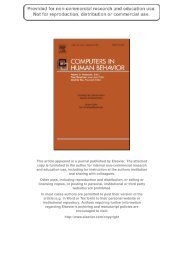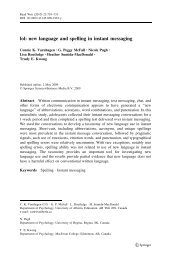Warschauer.pdf
You also want an ePaper? Increase the reach of your titles
YUMPU automatically turns print PDFs into web optimized ePapers that Google loves.
46 Learn Inq (2007) 1:41–49<br />
to at-risk students, such as those with learning disabilities, limited literacy, and<br />
language skills, or insufficient background knowledge. Such students are least able to<br />
cope with unstructured environments because such environments place too heavy a<br />
cognitive load on the learner (Feldon, 2004; Kalyuga, Ayres, Chandler, & Sweller,<br />
2003).<br />
In summary, the ability to learn autonomously will indeed be critical in the digital<br />
future. However, paradoxically, strong mentorship is required for students to<br />
achieve this autonomy, while an overemphasis on student independence can leave<br />
students floundering.<br />
The where paradox: out-of-school versus in-school learning<br />
The how paradox is closely related to the where paradox. Autonomous learners can<br />
learn anywhere. Particularly using digital media, people of all ages can learn in outof-school<br />
settings like never before, through accessing online information, using<br />
educational or edutainment software, participating in online communities, or playing<br />
individual or multiplayer games. These powerful forms of out-of-school learning are<br />
viewed as making formal education less relevant, especially when schools prove less<br />
than fully capable of successfully incorporating new media in instruction (see, e.g.,<br />
Gee, 2003, 2004).<br />
The paradox here is that, at the same time that new opportunities increase for<br />
powerful out-of-school learning, formal education is actually rising rather than<br />
falling in its impact on people’s lives. For example, whereas in 1975, the average<br />
person with an advanced degree earned twice as much as a high-school dropout, by<br />
1999 the same ratio was greater than 3.7. Those entering the workforce with a<br />
bachelor’s, master’s, or professional degree today are expected to earn $1.1 million,<br />
$1.5 million, or $3.4 million more, respectively, than a high-school dropout over a<br />
40-year career (Day & Newburger, 2002). A total of 49 out of the 50 highest paying<br />
jobs in the US now require a bachelor’s degree or higher, with the sole exception<br />
being that of air traffic controller (Bureau of Labor Statistics, 2005).<br />
A fascinating example of this paradox is seen in a recent paper by Albright,<br />
Purohit, and Walsh (in press) on literacy practices by Chinese immigrant youth in<br />
New York. The authors involved the immigrant teenagers in documenting their own<br />
out-of-school literacy practices and noted resistance from the some of the youth in<br />
recognizing the value of literacies involved with playing games, downloading music,<br />
or engaging in other non-academic online activity. Specifically, the students distinguished<br />
between those literacy practices most directly related to academic success,<br />
which they valued, and those not seen as related, which some saw as a waste of<br />
time—a bifurcation that the authors found troubling. In reading the paper, I could<br />
not help but note the gap in attitudes between the Chinese immigrant students, who<br />
are being socialized to value the types of literacy that they, their families, and<br />
community believe will contribute to academic success, and the Columbia University<br />
authors of the study, who took a more celebratory approach to all out-of-school<br />
literacy practices. The authors undoubtedly show insight in recognizing the broad<br />
range of unheralded literacy practices that youth engage in, but the youth themselves<br />
appear more keenly aware of what literacy practices are likely to enhance their life<br />
opportunities.<br />
123
















